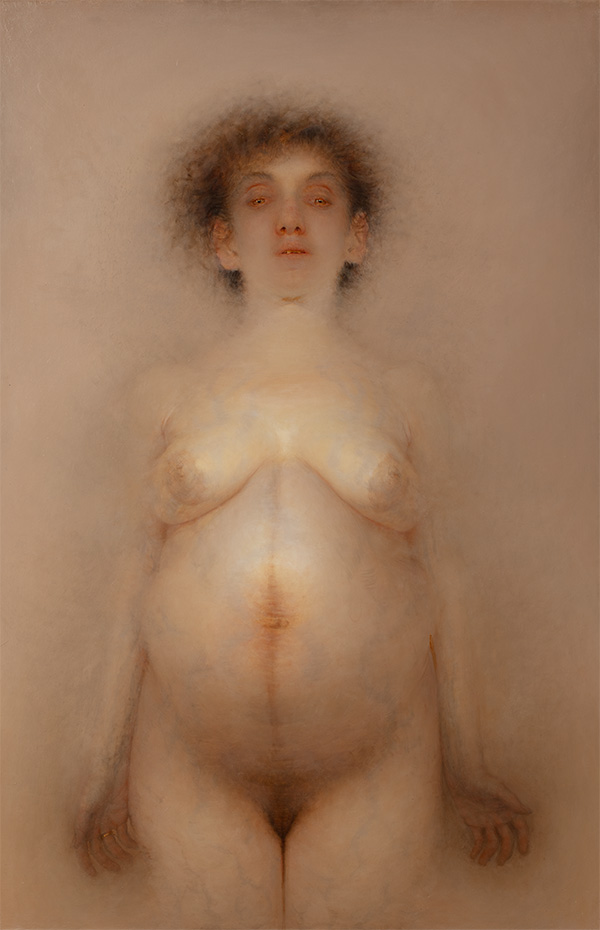Object of the Month: ‘Second Portrait with Max’ by Anne Harris
By Bowdoin College Museum of Art
Anne Harris, Second Portrait with Max, ca. 1996-1997, oil on canvas. Bowdoin College Museum, Brunswick, Maine. Anonymous Gift and Museum Purchase, Lloyd O. and Marjorie Strong Coulter Fund. © Anne Harris
Featured in the Bowdoin College Museum of Art’s ongoing exhibition Currents: Art Since 1875, the painting Second Portrait with Max offers a powerful—and even somewhat unsettling—depiction of pregnancy and its many implications. The painting was created by American artist Anne Harris, a resident of Portland, Maine for over a decade and assistant professor in Bowdoin’s Visual Arts Department from 1994 to 1997 and later visiting lecturer from 2000 to 2001. In 2003, the Bowdoin College Museum of Art organized a solo exhibition of Harris’s work entitled Without Likeness: Paintings by Anne Harris. Harris currently teaches as a professor of painting and drawing at The School of the Art Institute of Chicago.
Contemplating her new identity as a mother, Harris painted this portrait while anticipating the birth of her child, Max, and considers it a “big breakthrough painting” in her career.[1] Although Harris always begins by looking into the mirror, her portraits often redesign her self-likeness to reflect how she feels or perceives herself. She meticulously builds up the oil paint to accurately capture the translucent nature of her skin, allowing the subtle undertones of blue, green, and purple from her swollen veins to show through.[2] About her process, Harris has explained, “I’m inside myself, looking out of myself, trying to look back inside.”[3]
In her painting process, Harris pays special attention to the presence of air that envelops her figures, which often blurs the lines between her body and her surroundings. In some areas, her arms and head diffuse into the nude background. Thus, the entire portrait becomes a bodily extension of her fertile physicality, as if a sort of amniotic fluid engulfs her.[4] Light plays a crucial role in Harris’s portraits, as she begins painting in the sternum area, which often radiates light, and then moves outward to the extremities of the body. Her breasts and stomach, two parts of her body that are vital for birthing and breastfeeding, glow with ethereal rays and “threaten to rupture the surface of the painting itself.”[5] Her head and arms, however, recede into darkness, suggesting the immense self-sacrifice required to give birth. Using these formal elements, Harris expresses the psychological undercurrents of a pregnant person and implies an inherent self-grieving that pregnant people often confront—the “annihilation” of oneself required to give birth, or “abjection” described by French philosopher Julia Kristeva. Harris is entirely naked, except for the gold wedding ring placed unobtrusively on her left hand; she simultaneously pays homage to her husband, an important support during her pregnancy, while also identifying marriage as another form of work and sacrifice.
Juxtaposing modern and contemporary art from the Museum’s Permanent Collection, Currents: Art Since 1875 explores diverse associations of “Labor/Bodies,” “Migration/Environment,” and “Inspiration/Appropriation.” Featured in the “Labor/Bodies” section of the exhibition, Second Portrait with Max asks the viewer to reframe how they think of labor in terms of domesticity, maternity, and womanhood.